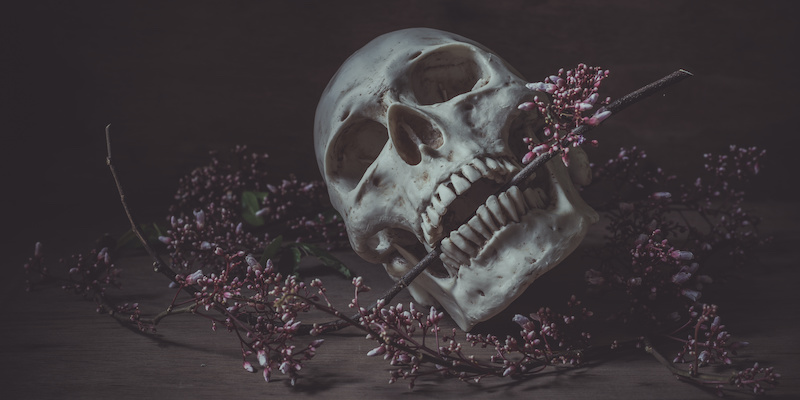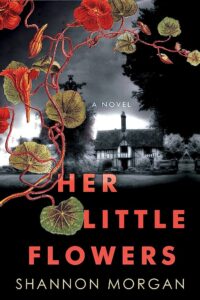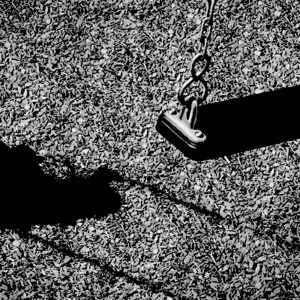It’s a small bugbear of mine that gothic and horror are so often lumped together as the same genre. Many would argue that gothic is a subgenre of horror, but as a reader and writer of gothic fiction, I would have to disagree. There is, of course, a blurring of the lines between the two, as is the case in most genres, but they are quite distinct in the reaction they instill in the reader.
According to the Cambridge University Dictionary the definition of horror is to ‘create a strong feeling of fear and shock,’ for gothic—once you get past all the bits about Gothic architecture and Gothic tribes of yore—it says ‘writing or films in which strange things happen in frightening places.’ Neither definition is terribly helpful.
Both genres have a long and varied history in literature. Horror has been around since the year dot, setting its roots down in folklore around the world. And for centuries, horror was at its purest, feeding into our human fears of monsters, that shiver in the dark, and all those nasty things that preyed on us that we couldn’t explain. There isn’t a culture or civilization that doesn’t have dark and nasty creatures that steal out of the night to terrify clawless, fangless humans. But as we advanced and started explaining away our fears with science and new technologies, and we no longer lived cheek-by-jowl with the monsters of the night, we never truly lost our fears of the unknown.
It was in the eighteenth century, in the age of Romanticism, that the lines of horror began to blur. Now that we no longer truly believed in vampires and werewolves, writers began to explore what we still didn’t know, what we couldn’t explain, drawing on our past fears to create fears for the more assured, modern humans who still wanted that oddly perverse human trait: to be frightened. These new stories set out to make us feel the horror we’d lost with the advances of civilization, framing our new fears of the unexplainable within a social scaffold, to toy with our obsessions of death – the one real great unknown left – but with a touch of romance to shock and titillate the more jaded sensibilities of the modern reader of the eighteenth and nineteenth century. And so a new subgenre was born, gothic horror.
In its infancy, gothic literature was seen almost as satire, extravagant and indulgent, that appealed largely to women and was therefore considered inferior. These stories were often written by women for women, who used the supernatural to reveal their frustration of their enforced domestic role in society, their second-class status, their enforced subservience in a world built by men for men. It’s therefore not surprising that gothic books in the form of penny dreadfuls were seen as less than, an inferior second to male-written horror.
Roll on a couple of hundred years to the present, and the boundaries between gothic and horror, while still blurred, have firmed into distinct genres. Yet horror is still primarily written by men, and gothic is still written largely by women.
More recently, and to my delight, there has been a slight shift in gothic to modern gothic. It still isn’t a term used as often as I’d like to describe the works of gothic writers today, but it is appropriate for our age of readers that still loves the gothic genre with its gloom and romance, but brings stories with a modern twist that’s more in keeping with our modern lived experiences, providing a more relevant social commentary.
As I delved deeper and looked hard at the books of horror and gothic I’ve read, it came to me that perhaps the divide is still more gender-based than I’d realized. Look at the most famous horror writers of more recent times—Stephen King, Grady Hendrix, HP Lovecraft, Dean Koontz with only a couple of woman authors to even things marginally, such as Anne Rice and Shirley Jackson (although I personally think Jackson fits very firmly in the gothic mould – again those blurring of lines). Yet when we look at the gothic authors, we get a more varied view of the authors of the past couple of centuries: Ann Radcliffe, Emily Bronte, Daphne du Maurier, Henry James, Lord Byron, Oscar Wilde and Edgar Allen Poe. A number of these authors fall into both categories. Interestingly, Shirley Jackson doesn’t feature often on gothic lists, considered primarily horror.
But I was more interested in gothic written today and was not very surprised that they were almost all exclusively written by women such as Diane Setterfield, Silvia Moreno-Garcia, Laura Purcell, Kate Morton, Catriona Ward and more. Again, not surprisingly, all these authors are still more likely to be classified as horror.
Like all genres horror and gothic have tropes. For horror it’s supernatural, terrifying monsters of all forms who are, of course, super evil and hard to kill, isolated settings, a sinister castle, manor or similar, a brave but stupid hero/heroine who will definitely go into that dark room with echoing noises, cults and ancient curses that have terrified the local population for centuries, technology that suddenly and mysteriously stops working, suspicious, invariably creepy neighbors, and most importantly, the requirement to scare the shit out of the reader with shocking twists and turns, life and death situations where there can only be one survivor. Additionally, in horror there is always a resolution at the end of the story when the monster is destroyed and the horror is resolved.
Gothic fiction tropes are more nuanced with some overlap: the isolated setting with a dilapidated castle or similar, an antisocial character who stubbornly remains in said dilapidated castle or similar, a long-suffering, but loyal servant who walks the dark halls and keeps their master/mistress’ secrets, atmospheric writing, unsolved mysteries that still touch the living, the suggestion of something supernatural that is often never seen but felt, foreboding suspense, intense emotion, a damsel in distress and the reclusive hero who will save her or needs to be saved which always leads to romance. Furthermore, in gothic fiction, while the mystery is resolved by the end, it is often not the end of the story but assumes a lingering emotional impact for the characters’ lives for years to come.
Interestingly, the only clear overlap of the tropes is the isolated setting, often with a dilapidated castle or similar, the rest is a blurring of the lines once again.
For me, what really defines horror from gothic is the style of writing and the atmosphere, the way the writing makes me feel.
Horror’s main objective is to disturb the reader, to scare, and to repulse. Ann Radcliffe put it quite perfectly, when in 1826, she said, ‘Whereas terror is a feeling of dread that takes place before an event happens, horror is a feeling of revulsion or disgust after the event has happened.’
The horror writer wants to provoke emotion or a physical, toe-curling, fearful reaction in the reader. The monsters are often physical manifestations that are a genuine threat to life, a fight between good and evil (humans always being the good guys). The language is often graphic and gory, it does not generally dabble in purple prose and pretty imagery but goes for the visceral punch in the gut with baldly painted narratives.
Gothic is subtler, it doesn’t grab you by the throat to terrify you. Gothic is a gentle creep of dread. It uses supernatural monsters as a device, shining a light on the monster within, the monsters humans, sadly, so often are. Often the supernatural elements are ambiguous, more a suggestion, a superstition, a claustrophobic alertness, that prickle of the nape that something is watching. It focuses more on the domestic scene, dealing with the tragedies and unsolved mysteries of the past that still haunt the living. It frequently highlights male abuse and control women have endured that still resonate in today’s society. The language used is quite different to horror, liberally sprinkled with purple prose, and dark, moody imagery (Gothic writers love mist!), the castles, manors etc. are often a personality in their own right, the tragedies of the past leaching from their walls. Gothic stories are often told in dual timelines, stories within stories, tragedies inherited, haunting each generation.
So while there may be a blurring of the tropes of gothic and horror, they should be distinct genres because of the very different ways they make a reader feel. We do readers a disservice by placing gothic and horror in the same category. It leads to expectations that won’t be fulfilled and thereby damages the reader’s enjoyment of the book. There are readers of horror who will be disappointed when they read a book classified erroneously as horror that doesn’t give them the thrills and chills they’d expect of a horror, but the gentler menace of gothic. And there are those readers who hate horror, but would probably love the quieter creep, the more human element and atmospheric writing of gothic.
***


















